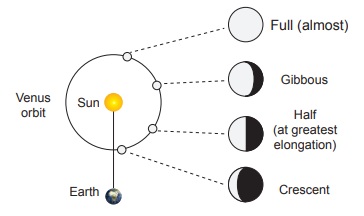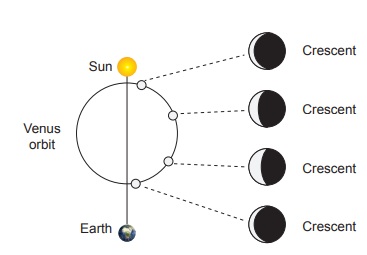Universe and Space | Term 3 Unit 2 | 7th Science - Questions Answers | 7th Science : Term 3 Unit 2 : Universe and Space
Chapter: 7th Science : Term 3 Unit 2 : Universe and Space
Questions Answers
EVALUATION
I. Choose the correct answers
1. The moon takes _________ days
to complete one revolution around the Earth
a.
25
b.
26
c.
27
d.
28
[Answer: (c) 27]
2. If the Moon is appeaing in the
sky today near the star Karthikai , the position of the Mon after 27 days is
near the star
a.
Bharani
b.
Karthikai
c.
Rohini
d.
Asvini
[Answer: (d) Asvini]
3. Telescope was invented by
a.
Han Lippershey
b.
Galilio
c.
Nicolus Coppernicus
d.
Ptolomy
[Answer: (a) Han Lippershey]
4. The galaxy containing young
and hot stars is
a.
elliptical galaxy
b.
irregular galaxy
c.
cluster
d. spiral galaxy
[Answer: (d) spiral galaxy]
5. With the launch of this
satellite, ISRO became capable of launching 4 ton heavy satellites.
a.
GSAT- 13
b.
GSAT- 14
c.
GSAT- 17
d.
Way par GSAT- 19
[Answer: (d) Way par GSAT-19]
II. Fill in the blanks.
1. Waxing of moon means growing or expanding.
2.
Heliocentric model is proposed by
3. The Big Bang Theory is the prevailing model of Evolution of the Universe
4. Ursa Major is a large constellation which covers a large part of the sky.
5.Aryabhatta is the first satellite launched by India
III. True or False – If
False give the correct answer
1. On a full moon day, when the Sun is setting in the west, moon rises in the West. Answer: False.
Correct statement: On a full Moon day, when the Sun is setting in the west, Moon rises in the East.
2.
The word crescent refers to the phases where the moon is less than half
illuminated.
3. Galilio accepted the Geo-centric model.
Correct statement: Galilio did not accepted the Geo-centric model.
4.
Our Milky Way galaxy is identified as an elliptical galaxy.
Correct statement: Our Milky Way galaxy is identified as an spiral galaxy.
5.
The planet Venus in our solar system doesn’t have a moon.
IV Match the following
1.
Rohini - GSLV-Mark III
2.
GSAT-14 - GSLV Mark III M1
3.
GSAT-19 - SLV-3
4.
Chandrayaan-2 - PSLV-XL C25
5.
Mangalyaan - GSLV-D5
Answer:
1. Rohini : SLV-3
2. GSAT-14 :
GSLV-D5
3. GSAT-19 :
GSLV Mark III DI
4. Chandrayaan-2 : GSLV-Mark
III
5. Mangalyaan :
PSLV-XL C25
V Analogy
1. Older stars : elliptical galaxies :: younger stars : Irregular galaxies.
2.
Nearest galaxy : Andromeda :: Nearest star :
VI Very short answer
1. The word cresent refers
to the phases where the moon is less than half illuminated (cresent / gibbous)
Answer: cresent.
2. Mercury and Venus planets never appear in the mid-night sky.
Answer: Mercury, Venus.
3. Number of days taken by the Mars to orbit around the Sun.
4. In which phase does the size of the planet Venus is small?
5. The only evidence of the big bang theory is
6.
The galaxy which contains abundant amount of gas and dust is
Answer: Spiral galaxy.
7.
Which country launched the world’s first artificial launch vehicle?
VII Short Answer Questions
1. What is epicyclic model?
Answer: (i) To explain the puzzling phenomena astronomers in early times
proposed a change in the simple geocentric model. This is called as epicycle
model.
(ii) A small circle whose centre is on the circumference of a larger
circle, in ptolemic astronomy.
(iii) It was seen as the basis of revolution of the seven plants,
given a fixed central Earth.
2. Name the four different types
of galaxies.
Answer: (i) Spiral galaxy (ii) Elliptical
galaxy (iii) Irregular galaxy (iv) Barred
spiral galaxy
3. What is constellation?
Answer: A
constellation is a recognizable pattern of stars in the night sky when viewed
from the Earth.
4. Give the expansions of PSLV
and GSLV
Answer: PSLV : Polar Satellite Launch Vehicle.
GSLV : Geosynchronous
Satellite Launch Vehicle.
VIII Answer in Detail
1. Explain
the waxing and waning phases in Venus
Answer:
(i) As the Venus went around the epicycle, as shown in the diagram
Venus would exhibit phases.
(ii) Also at times the planet would be nearer, making the apparent
size grow bigger and at times far making the apparent size smaller.

(iii) If the Venus was going around the Sun, and its orbit is inside
that of Earth, Venus would appear always near the Sun in the sky.
(iv) It can never be seen in the midnight sky. Two when it is near
the Earth, it would be brighter and bigger compared to when it is on the other
side of the Sun.
(v) Thirdly only if the Venus is revolving around the Sun, it can
exhibit gibbous phase, and the size of the gibbous phase smaller than the
crescent phase.
(vi) If the Venus was revolving around the Earth, we can never see
the gibbous phase of the Venus and it would be seen only if it is orbiting the
Sun.

2.
Write short notes on constellations.
Answer: (i) A constellation is a recognizable pattern of stars in the night
sky when viewed from the Earth.
(ii) International Astronomical Union has classified 88
constellations to cover the entire celestial sphere.
(iii) Many of the old constellations have Greek or Latin names and
are often named after mythological characters.
(iv) Ursa Major (Saptha Rishi Mandalam) is a large constellation and
it covers a large part of the sky.
(v) The most striking feature of this constellation is a group of
seven bright stars known as big dipper (seven Sages in Indian astronomy).
(vi) Ursa Minor in Lattin means ‘the little bear’ it lies in the
northern sky.
(vii) The Pole star - Polaris (Dhrua) lies within this constellation.
(viii) The main group, ‘little dipper’, consists of seven stars and is
quite similar to that found in Ursa Major.
IX. HOT Question
Neelan
and Mala are having a conversation about our Universe. Neelan is telling our
earth will be the only planet in the entire Universe to have a life with. But,
Mala is opposing his view by citing certain points. What would be the argument
of Mala. Do you support Mala? Justify your stand.
Answer: I would like to support Neelan, because Life is possible only on
the Earth due to presence of water, oxygen, various gases and suitable temperature,
which enables us to live.
Mala opposed Neelan’s view based on the following points :
(i) Like the Sun, there might be billions of other stars with their
own planets revolving around them.
(ii) Thus there are many chances of any planet getting the suitable
conditions for supporting life.
Related Topics